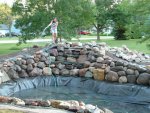Now I'm a little ambivalent about what to do. I have way more than enough liner to easily exceed overlap requirements as described here. I have 8 feet of width for a pond that is 2 feet deep. I can have the overlain liner go three feet beyond the water's edge and two or three feet across the bottom of the pond. Or some kind of combination of excess on top and at the bottom. The 10 feet of length, meanwhile, is enough to cover the lowest edge that needs to be lifted up. (The existing liner, except for by the skimmer, also goes about two feet beyond the pond edge at that spot already.)
Morewater, you are right that the holes are for pipes and power cords entering/exiting the skimmer box. They are where water drained from. I just watched it happen again after intentionally filling the pond high enough to see if it would happen again, but because of the duct tape, the water seeps out imperceptibly. It took a few hours for it to lose about 1/4 inch.
I'm not sure I explained the freeze situation clearly enough. I don't think the ground froze. I think the water that was already under the liner froze. I'd say I overfilled the pond by three inches in the days immediately preceding the deep freeze, because I hadn't yet realized the water would escape those skimmer holes. That three inches of water under the liner, upon freezing, expanded and pushed up the water that was still in the pond. The water on the pond surface did indeed freeze, solidly. The significance of the net is that the ice surface became, in effect, identical with the netting. Because the netting also dropped down to touch the water surface under the weight of the ice, there became a solid ice plane that followed the contours of the netting, but that also dipped down to include much of the pond surface. That is how I think water continued to get behind the liner. I'm only speculating, but there was a LOT of water under the liner after the freeze, and the only water that got back there after I refilled the pond after the thaw was the tiny bit that I made available to do that by overfilling the pond to reach those skimmer holes. I think I'll take some pictures tomorrow. By the way, we hit 58 degrees here today. I'll take that in December anytime.
Morewater, you are right that the holes are for pipes and power cords entering/exiting the skimmer box. They are where water drained from. I just watched it happen again after intentionally filling the pond high enough to see if it would happen again, but because of the duct tape, the water seeps out imperceptibly. It took a few hours for it to lose about 1/4 inch.
I'm not sure I explained the freeze situation clearly enough. I don't think the ground froze. I think the water that was already under the liner froze. I'd say I overfilled the pond by three inches in the days immediately preceding the deep freeze, because I hadn't yet realized the water would escape those skimmer holes. That three inches of water under the liner, upon freezing, expanded and pushed up the water that was still in the pond. The water on the pond surface did indeed freeze, solidly. The significance of the net is that the ice surface became, in effect, identical with the netting. Because the netting also dropped down to touch the water surface under the weight of the ice, there became a solid ice plane that followed the contours of the netting, but that also dipped down to include much of the pond surface. That is how I think water continued to get behind the liner. I'm only speculating, but there was a LOT of water under the liner after the freeze, and the only water that got back there after I refilled the pond after the thaw was the tiny bit that I made available to do that by overfilling the pond to reach those skimmer holes. I think I'll take some pictures tomorrow. By the way, we hit 58 degrees here today. I'll take that in December anytime.


